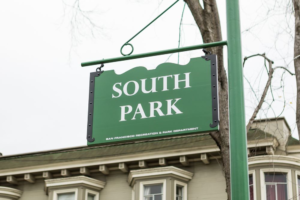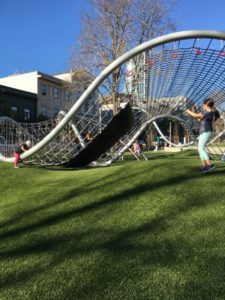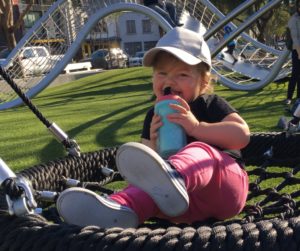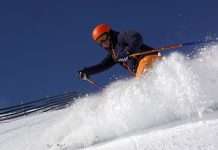 This past month, the city of San Francisco unveiled the newly transformed South Park after its $3.8 million renovation project. As San Francisco’s oldest public park, the large and historic space had fallen into significant disrepair over time. Now, South Park boasts walkways, meadows, mature trees, places to work or sip coffee (or both!), and a significant children’s play structure.
This past month, the city of San Francisco unveiled the newly transformed South Park after its $3.8 million renovation project. As San Francisco’s oldest public park, the large and historic space had fallen into significant disrepair over time. Now, South Park boasts walkways, meadows, mature trees, places to work or sip coffee (or both!), and a significant children’s play structure.
When I attended the ribbon-cutting ceremony to celebrate the South Park re-opening, I couldn’t help but overhear a few parents commenting on the strange design of the new “park.” On first glance, I’ll admit that the web of ropes and rubber can be a bit intimidating. It has few, if any, traditional park components: no colorful slides, no infant swings, and no clear areas to go up, down, or even get onto the play structure. But, the contemporary design of this structure is exactly why it’s an important park for children to visit.
 Children spend a lot of time being told how to think, how to act, and what to do. Although this is an important part of growing up and learning how to exist in our society, children need time and space to explore without boundaries. Most of us think, “Well sure, that’s what the park is for!” But even the park is full of rules: the stairs are for going up, the slide is for going down, the seesaw is for bouncing, the swings are for sitting in, and you must always wait for your turn.
Children spend a lot of time being told how to think, how to act, and what to do. Although this is an important part of growing up and learning how to exist in our society, children need time and space to explore without boundaries. Most of us think, “Well sure, that’s what the park is for!” But even the park is full of rules: the stairs are for going up, the slide is for going down, the seesaw is for bouncing, the swings are for sitting in, and you must always wait for your turn.
A non-traditional park, like the South Park structure, offers children a blank canvas for explorative play. In his NY Times article ‘Let the Kids Play,’ David Kohn discusses how our society’s tendency to over-structure our children’s lives can greatly discourage their natural need for active exploration and play. But why is explorative play so important? When children are provided with non-structured play options, it helps them develop skills like innovation, problem solving, abstract thinking and creativity. They learn to persevere, gain self-control and push to reach their next personal best.
 When I first took my daughter, even I had a few doubts about how she would play at this park. But within a few minutes she was doing things that I didn’t even know she could do! She was interacting with the structure in very different ways than I could have imagined, and enjoying every minute of it. Each time we visit, she finds a new way to play, a new area to explore, and a new challenge to take on. Most importantly, she showed me that a park doesn’t have to tell you how to play in order to have fun!
When I first took my daughter, even I had a few doubts about how she would play at this park. But within a few minutes she was doing things that I didn’t even know she could do! She was interacting with the structure in very different ways than I could have imagined, and enjoying every minute of it. Each time we visit, she finds a new way to play, a new area to explore, and a new challenge to take on. Most importantly, she showed me that a park doesn’t have to tell you how to play in order to have fun!
San Francisco residents are truly lucky to have access to such a unique park that promotes healthy development in our children. Hope to see you on the ropes!

















